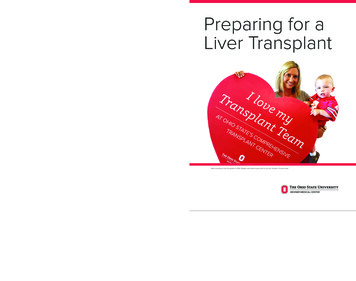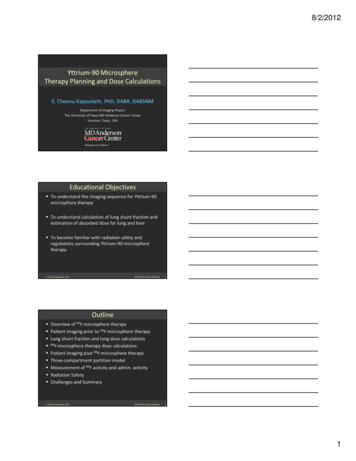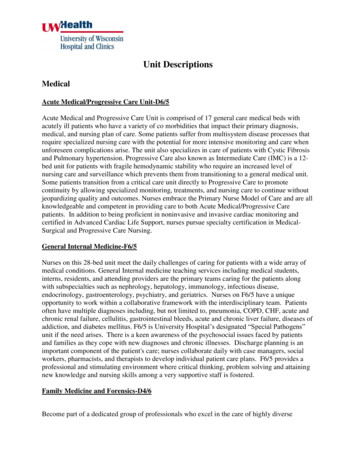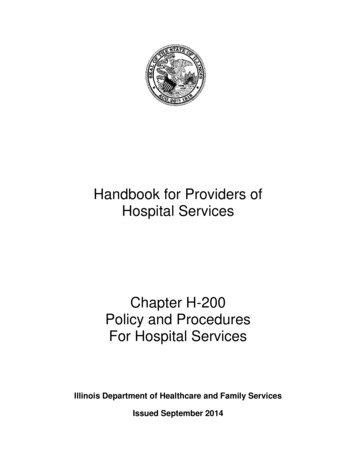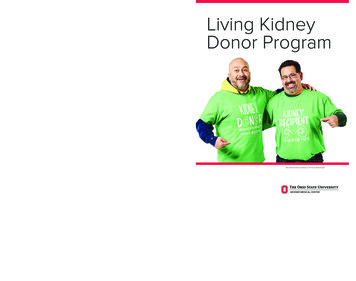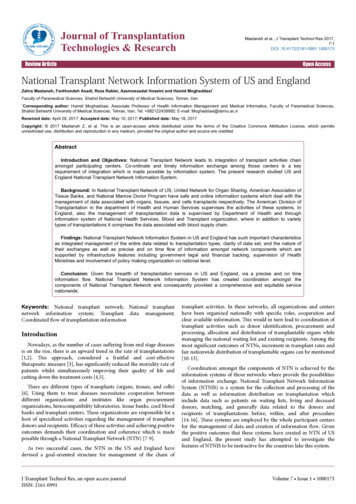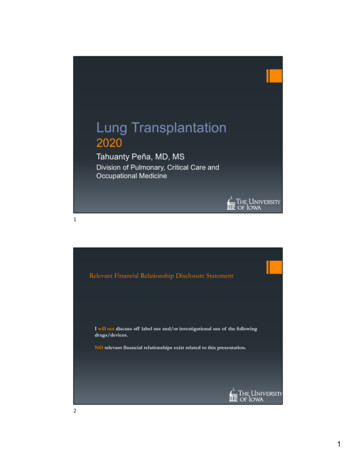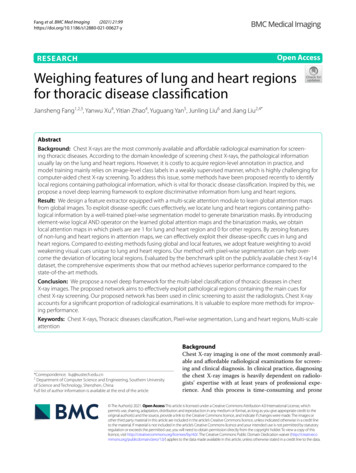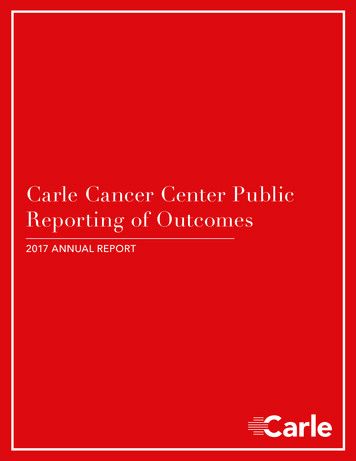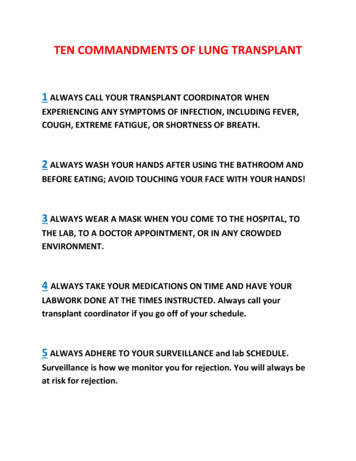
Transcription
TEN COMMANDMENTS OF LUNG TRANSPLANT1 ALWAYS CALL YOUR TRANSPLANT COORDINATOR WHENEXPERIENCING ANY SYMPTOMS OF INFECTION, INCLUDING FEVER,COUGH, EXTREME FATIGUE, OR SHORTNESS OF BREATH.2 ALWAYS WASH YOUR HANDS AFTER USING THE BATHROOM ANDBEFORE EATING; AVOID TOUCHING YOUR FACE WITH YOUR HANDS!3 ALWAYS WEAR A MASK WHEN YOU COME TO THE HOSPITAL, TOTHE LAB, TO A DOCTOR APPOINTMENT, OR IN ANY CROWDEDENVIRONMENT.4 ALWAYS TAKE YOUR MEDICATIONS ON TIME AND HAVE YOURLABWORK DONE AT THE TIMES INSTRUCTED. Always call yourtransplant coordinator if you go off of your schedule.5 ALWAYS ADHERE TO YOUR SURVEILLANCE and lab SCHEDULE.Surveillance is how we monitor you for rejection. You will always beat risk for rejection.
6 ALWAYS AVOID EXPOSURE TO SMOKE, DUST, MOLDYENVIRONMENTS, AND RESPIRATORY IRRITANTS.7 ALWAYS AVOID EXPOSURE TO THE SUN; WEAR SUNSCREEN ANDPROTECTIVE CLOTHING ANYTIME YOU ARE OUTDOORS.8 ALWAYS CALL FOR MEDICATION REFILLS WELL BEFORE YOU RUNOUT OF MEDICINE!9 ALWAYS AVOID ILL CONTACTS, EVEN IF THEY ARE RELATED!!10 ALWAYS BRING YOUR BLUE MEDICATION CARD TO CLINIC. Youshould also bring your blue medication to any medical appointmentincluding your Primary Care Provider.
Module 1: INFECTIONBackgroundSeveral of the medications you are taking are called “immunosuppressants.” By decreasing the strengthof your immune system, these drugs limit your body’s ability to recognize the donor lungs as foreign. Butwith a suppressed immune system, you will be at increased risk for different types of infection.Always remember that using prevention strategies is the single most important thing you cando.Types of Infection BacterialViralFungalParasiticPreventionHand HygieneThis is the single most effective measure you can use to reduce your risk. Wash with soap and water for at least 30 seconds.Use alcohol based gels when soap and water not available.Avoid touching surfaces that may not be cleaned regularly.Avoid touching your face.Do no reuse tissues.Avoid cleaning moldy areas (bathrooms), litter boxes, animal cages and fish tanks.Wash your hands after petting animals, handling money and touching objects that may be dirty.Do not change diapers of children who have been recently vaccinated.Sick Contacts Avoid anyone who has been sick recently (even those with the “common cold”).If someone in your household is sick, both parties should wear a mask and be diligent about theprevention measures listed above. Refer to the cold and Flu handout for more detailedinformation.Avoid crowed environments if possible. Wear a mask when you are within arms distance ofothers. Always wear a mask when using mass transportation (buses, planes and trains).
Exposures and Environment Avoid dust, smoke, construction and remodeling areas when possible. This includes fireplaces.If you have fresh flowers, have someone change the water daily. You can add 2 drops of bleachto the water.Always avoid standing pools of water and stagnant ponds.No hot tubs or saunas.Only swim in treated pools and fresh water (after approval from your doctor).No swimming or tub baths for at least the first 6 months.Avoid gardening. This is potentially very dangerous.Wear a mask when you will be around strong fumes and perfumes (e.g., hair salon).Be wise about when you will be in crowded areas. Try to pick off-peak hours for dining, shoppingand traveling.All meats need to be cooked well-done, no pink. No Sushi.Signs and SymptomsEarly recognition of infection leads to early treatment and can help preserve the integrity of your newlungs. It is up to you to alert the Lung Transplant Team if you think you are developing an illness.ANY SYMPTOM, NO MATTER HOW SMALL, SHOULD NOT BE IGNORED.Call the clinic if you have any of the following symptoms: Temp 99.0 F. Ok to take acetaminophen (Tylenol) after contacting the clinicCold/Flu Symptoms: cough, shortness of breath, sputum production, fatigueBody aches, chills and/or night sweatsNew skin rashChange in your incisions (redness, pain, swelling, tenderness, drainage)Weight gain or loss (usually a change of greater than 5lbs in a week).If your blood pressure is greater than 170/100 or less than 100/60.If you start developing reflux or heartburn symptoms.Nausea, vomiting and/or diarrheaIf you develop diarrhea, you MUST call. Do not treat with antidiarrheal meds.
Module 2: REJECTIONBackgroundYour donor lungs are recognized as foreign tissue by your body’s immune system. Rejection is anatural response of your body’s defense mechanism. If left untreated, rejection may causesevere and/or irreversible damage to the donor lungs.TypesAcute Rejection: Usually occurs in the first 6 months but can occur anytime. Certain immunecells (known as T-lymphocytes) attack the donor lungs.Chronic Rejection: Clinical syndrome that generally occurs over time. Risk factors include, butare not limited to, prior episodes of acute rejection, gastroesophageal reflux (GERD) andprevious viral infections.Diagnosis Radiographic imaging: CT scans, Chest X-raysSigns and symptoms: Similar as described in the Infection Module (fever, shortness ofbreath, cough, sputum production, change in your blood pressure or weight).Bronchoscopy and tissue biopsy (done during the bronchoscopy).Treatment Usually requires an adjustment in your immunosuppressant regimen.Prevention Be aware of the signs and symptomsMaintain a strict compliance with your medication regimenIt is very common to develop GERD (reflux) after Lung Transplant even if you didn’t havesymptoms before surgery. This can occur while you are sleeping and may not know it ishappening. We strongly encourage you to prop the head of the bed up so that the head ishigher than the feet. This cannot be done with pillows but can be done with phone books,cement or wood blocks or a device called Mediwedge.
Module 3: Self-Monitoring and Personal ResponsibilityBackgroundAs a lung transplant recipient, it is important for you to be mindful about notifying the Lung TransplantTeam for any life changes, travel, new symptoms, or new medications you are taking. The key to havinga successful post-transplant life is taking personal responsibility.Laboratory Monitoring Initially you will need to have blood drawn twice weekly (Mondays and Thursdays)You must get your blood drawn at 8 am in the morning on lab days. The lab is open at7:30am.DO NOT take any medications before your blood draws. But DO bring your medications withyou and taken them immediately following completion of your blood work.EquipmentBlood Pressure Cuff Please check and record your blood pressure at the same time twice daily.Call the clinic if your blood pressure is greater than 170/100 or less than 100/60.Glucose Monitoring Kit Refer to the pharmacy section for how often you should be checking your blood sugar.Record all of your blood sugar checks and how much insulin you are taking.Thermometer Please check and record your temperature twice daily (usually along with your bloodpressure).Call the clinic if you temperature is greater than 99.0 F.ID Bracelet Always wear your medical alert bracelet that identifies you as a transplant recipient. Weigh yourself at the same time everyday with the same amount of clothing.ScaleCall the clinic if you gain more than 2 lbs in 24hours or 5 lbs in one week.
SurveillanceDuring the first several months following transplant, there will be an intensive follow-up and testingperiod. During this time, the Lung Transplant Team will closely monitor your symptoms, lung functionand taking regular X-rays. Your nurse coordinator will help you organize all the various appointments. Astime progresses, there will be fewer appointments and testing.Bronchoscopy By now, you should be familiar with this procedure.Do not eat or drink ANYTHING after midnight the day before your procedure.Please bring your medication with you to the bronchoscopy procedure. You will be able totake them afterwards.You MUST be accompanied by an adult for each procedure. You will likely receive sedationand cannot drive for 24 hours.After the procedure, a slight fever is common.A very small amount of blood with coughing may be normal. Call your coordinatorimmediately or go the nearest emergency room if you experience bright red blood orproduce more than one teaspoon.CT Scans These are done on the 3d floor of the hospital in the radiology department.No special preparation is required.Spirometry Generally done either in the 13th floor of the hospital or the 5th floor of the clinic.Clinic Visits During your routine visits, you will have access to your physician, nurse coordinator,pharmacist and dietician.ALWAYS write down your questions beforehand and bring them to the visit.Personal Responsibility NEVER hesitate to call your coordinator or the physician on call.ALWAYS wear a mask when in crowded places.Report any symptoms, no matter how small, to your coordinator. You Lung Transplant Teamwill help you decide what steps to take next.Keep track of your medication stock and refill your supply in a timely manner.Never take another medication until it’s been cleared by the Lung Transplant Team.
Module 4: Life after TransplantBackgroundWe want you to enjoy your new lungs as much as possible! There will be precautions that you will needto take with certain activities, but our goal is to help you achieve a life of maximum quality.Exercise It’s common to feel weak and tired in the weeks following surgery.Increase your activity level daily. Start with 10 minute walks three times daily.Do not do any heavy lifting (greater than 10 lbs, about a gallon of milk in each hand) for atleast 6 weeks following the surgery. Check with the clinic staff as to when you can lift more.Generally, it’s ok to walk, bike, play golf or tennis and do yoga. But do not start within thefirst 6 weeks after transplant. Check with the clinic staff before participating in anystrenuous activity.Diet Refer to the nutrition section for details about your specific nutrition needs.Sexual Activity Wait 6 weeks before resuming sexual activity.Modify your position to avoid weight-bearing in the upper body.Condoms are an acceptable form of contraception.Females: check with your gynecologist for alternative birth control options.Sun Exposure Some of your medications increase your risk for skin cancer. Your pharmacist will explainthis in further detail.Always wear a broad –spectrum (covers UVA and UVB) sunscreen (even on a cloudy day).Wear at least 50 SPF. Pay special attention when applying to your ears, nose, forehead,scalp and arms. Apply every 2 hours in general and every 1 hour if swimming or sweating.This is very important since sunscreen does not last all day.Use a wide-brim hat, sunglasses and long sleeved shirts. You may even purchase UVprotective clothing online or at sporting goods storesExam your body on a regular basis for changes in moles, new spots and changes of skincolor.You will need to see a Dermatologist (skin doctor) twice yearly. Your first appointment willbe within 3 months of your transplant.
Travel Always check with the clinic prior to any travel (even for short trips).No international Travel for 1 year post transplant.Plan to use bottled water.Stay in reputable places.Always carry a full supply of medications. Always carry on your medications. Never checkthem in your luggage.Wear a mask when in crowded or public places.Driving No driving for 6 weeks post-transplantAlways sit in the backseat of the car. A car accident that activates the airbags can damageyour sternum (breastbone) in the first 6 weeks.Alcohol No alcohol for 6 months post-transplant. After such time, you may have limited amounts ofalcohol unless you have been asked to completely refrain from alcohol indefinitely.Routine Medical Screening Establish a relationship with your Primary Care Practitioner. S/he will help you organizeroutine medical testing and screening (such as cancer screening, bone density testing andimmunizations).See your dentist within 6 months of your transplant.See your ophthalmologist (eye doctor) yearly.As noted above, see your dermatologist (skin doctor) twice yearly.You will need a colonoscopy every 5 years.Females: see your gynecologist yearly. They will perform your PAP smears andmammograms.Males: see your primary care practitioner for prostate evaluation.Vaccines After you are out from transplant six months, you need to get your flu vaccine every year.You cannot get live vaccines at any time after transplant. Always ask before getting avaccine if it is live.If your family members get a live vaccine (like the shingles vaccine and fluMist) they cannothave contact with you for 2 weeks.Pneumonia vaccine every 5 years.
QUIZModule 1: INFECTION1. What is the single most important thing you can do to reduce infection:a. Wearing a mask in publicb. Washing hands with soap and water for at least 30 secondsc. Avoiding sick family and friendsd. Avoiding pets2. When should you call the Lung Transplant Team if you think you are developing an illness?a. Temp 99.0 Fb. Cold/Flu Symptoms: cough, shortness of breath, sputum production, fatiguec. Nausea, vomiting and/or diarrhead. All of the above. You should call the Lung Transplant Team if you have any of thesesymptoms3. One of your grandchildren is coming over for a visit today however they currently have a runnynose, sneezing and a cough. Your best option to avoid getting an infection is to:a. Wear a mask when the grandchild comes overb. Have your grandchild wear a mask when they come overc. Reschedule your visit for when they are not sickd. Nothing is wrong with them coming over in this conditionModule 2: REJECTION4. You are on immunosuppression medications. These medications decrease the risk of rejection.Please circle the medications which are your immunosuppression regimen:a. Voriconazole, Valganciclovir, Septrab. Tacrolimus (Prograf), Mycophenolate (Cellcept), Prednisonec. Albuterol, Amphotericin, Tobramycind. Aspirin, Metoprolol, Lipitor5.The symptoms of rejection and the symptoms of infection can be very similar: Shortness ofbreath, desaturation, fatigue and cough.a. Trueb. False6. Your tacrolimus (Prograf) needs to be at a certain level to work best. In order to measure thetrough level properly you should have the lab drawn after you take your morning dose.a. Trueb. False
Module 3: Self-Monitoring and Personal Responsibility7. After the first six months, you should get a flu vaccine yearly even though you areimmunosuppressed.a. Trueb. False8. Some of the medications can make your blood pressure high or low. This is one of the reasonswe want you to check your blood pressure twice a day, every day at the same time. At whatpoint will you call the Lung Transplant team:a. Your blood pressure is 160/85b. Your blood pressure is 105/65c. Your blood pressure is 170/100d. Your blood pressure is great than 20 points above your norm and you have symptomssuch as headache, dizziness, swelling or pallor.e. C and D9. It's ok to have a small cup of decaf coffee before your bronch.a. Trueb. False10. You should take your meds before having your blood drawna. Trueb. FalseModule 4: Life after Transplant11. Which of the following significantly increases your risk for skin cancer?a. Being immunosuppressedb. Taking voriconazolec. Living at altituded. All of the above12. You are planning a big trip for a week, traveling by car to Oregon to go hiking at Crater LakeNational Park. The first thing you need to do prior to leaving is:a. Check with the Lung Transplant clinic prior to any travelb. Change the air filters in the cabin of the car to reduce mold, bacteria and virusesc. Start a new antibiotic for infection preventiond. Take double your immunosuppression since you’ll be in the wilderness away frommedical personnel13. Your regular doctor wants to prescribe a new medication for you. Before you start any newmedication you should always:a. Do nothing since your non-transplant doctor will know all the drug interactionsb. Google whether the new medication is appropriate for youc. Call the Lung Transplant team and your nurse coordinator before starting any newmedication
d. Assume that your non-transplant doctor will call and discuss your new medication withthe lung transplant team
COLD AND FLU HANDOUTTake everyday preventive actions to stop the spread of germs and be proactive inreceiving immediate care for viral symptoms.1. CALL YOUR TRANSPLANT COORDINATOR IMMEDIATELY IF YOU HAVE ANY SIGNS ORSYMPTOMS OF THE FLU OR ANY OTHER RESPIRATORY VIRUS!!!!!!!!2. Cover your nose and mouth with a tissue when you cough or sneeze.3. Throw the tissue in the trash after you use it; do not re-use tissues4. Wash your hands often with soap and water frequently especially before eating andusing the bathroom. If soap and water are not available, use an alcohol-based hand rub.5. Avoid touching your face. Germs spread this way.6. Try to avoid contact with sick people (including children or grandchildren); if youobserve anyone near to you experiencing flu-like symptoms you should distanceyourself from them.7. If you feel as though you are becoming ill, call the lung transplant office right away tospeak with a care provider. (415) 353-4145, Option#1.8. While sick, limit contact with others as much as possible to keep from infecting them.9. If you get the flu virus, antiviral drugs may be prescribed to treat your illness.10. Antiviral drugs are different from antibiotics. They are prescription medicines (pills,liquid or an inhaled powder) and are not available over-the-counter.11. Antiviral drugs can make illness milder and shorten the time you are sick. They may alsoprevent serious flu complications. It’s very important that antiviral drugs be used early(within the first 2 days of symptoms).12. Flu-like symptoms include fever, cough, sore throat, runny or stuffy nose, body aches,headache, chills and fatigue. Some people also may have vomiting and diarrhea. Peoplemay be infected with the flu, and have respiratory symptoms without a fever.13. Drink plenty of liquids at the first sign of flu. Sick people with the flu need to drink extrafluids to keep from getting dehydrated. Mild fluid loss can most often be treated athome. Yet, severe dehydration is VERY serious and must be treated in the hospital.
If someone else in your household is sick, here are some tips to help you avoid the sameillness:1. 2. Make a Sick RoomTry to give the sick person their own room. If there is more than one sick person, theycan share the sick room if needed.If you have more than one bathroom, have sick people use one bathroom and wellpeople use the other one.Give each sick person their own drinking glass, washcloth, and towel.Stock these items in the sick roomTissuesTrash can with lid and lined with a plastic trash bagAlcohol-based hand rubFacemasks (Sick people should wear a facemask if available when they leave the sickroom or are around other people.)3.Obey Sick Room Rules Avoid having other people enter the sick room.The sick person should not have visitors other than the caregiver. If visitors must enter,they should stay at least 6 feet away from the sick person.Cover coughs and sneezes.Ask the sick person to cover their nose and mouth with a tissue when they cough andsneeze. Ask them to throw used tissues in the trash.Choose one caregiver.If you can, choose only one caregiver to take care of sick family members. If possible,ask someone else to be the caregiver. If you get the flu, it could be much more seriousfor you. Keep the air clean.Open a window in the sick room, if possible, or use a fan to keep fresh air flowing.
Patient:Date of Transplant:Medication OverviewThis is a general overview of your immunosuppressant regimen. The following medications are yourmost important medications to prevent rejection of your newly transplanted organ. Please pay specialattention to these medications and any changes in the dosages to reduce your chance of rejection andcomplications.1. Prednisone – This is a steroid to prevent and/or treat rejection. Your prednisone dose will bechanging during your course. The dose may increase or decrease depending upon your general clinicalpicture, however it will generally follow the schedule written out below. Important: Before loweringyour prednisone dose, please contact your lung transplant nurse coordinator a couple of days prior tomake sure this drop in your steroid dose is still appropriate. This will be critical for us to keep our chartsaccurate.Prednisone Taper Schedule: Please take prednisone as follows unless otherwise directed by amember of the Lung Transplant team.Post-Transplant DayDateDose2. Mycophenolate (Cellcept ) – This is another important immunosuppressant. Occasionallywe may stop or decrease the dose of this medication temporarily based upon your labs. If we change ordecrease your dose, it is important for you to ask the lung transplant nurse coordinator if the medicationhas not been restarted within 4 weeks after stopping or decreasing the dose.3. Tacrolimus (Prograf ) – We will be monitoring your tacrolimus level (or trough) periodicallyduring your course to ensure that your level is appropriate. On the days that you are getting your labsdrawn, please make sure that you do not take your morning dose so that the level we take is accurate.Remember, there are many drug interactions associated with tacrolimus so it is important to notify us ofany changes to your medications (including any over the counter medications that you have startedtaking). Your general tacrolimus level should be:0-3 months: 10-14 ng/mL3-6 months: 10-12 ng/mL 6 months: 8-10 ng/mL4. Azithromycin – We will start azithromycin 30 days after transplant to prevent long-termrejection. It is only taken on Mondays, Wednesdays and Fridays.
Prevention of InfectionThis is a general overview of the medications that you will be taking to prevent infection from occurring.Please pay special attention to these medications and any changes in the dosages to reduce your chanceof infection and complications.1. Voriconazole (Vfend ) – This medication will be used for approximately the first threemonths post-transplant to prevent fungal infections, particularly aspergillus. This medication has asignificant interaction with tacrolimus (Prograf ) so whenever we start or stop voriconazole, yourtacrolimus dose will have to be adjusted. If this medication is stopped or restarted, please contactthe lung transplant nurse coordinator with instructions to change your tacrolimus dose.2. Amphotericin B – This is an inhaled medication that you will take twice daily for the first 2months after your transplant. You might also restart this medication if you have an infection. If youhave just been transplanted, a home nurse will come to your residence to help you learn how to usethis medication once you leave the hospital. It is okay if you miss a few doses while waiting for thehome nurse to come. Instructions on how to make this medication suitable for inhalation is providedto you but wait for the home care nurse to demo. It is important to remember that this medicationneeds to remain refrigerated.3. Tobi or Tobramycin – This is an inhaled medication that you will most likely take for the first3 months (for 28 days on, 28 days off, then 28 days on). It is possible that you might continue takingthis medication longer, but in this case we would let you know. If you have just been transplanted, ahome nurse will come to your residence to help you learn how to use this medication once youleave the hospital. It is okay if you miss a few doses while waiting for the home nurse to come. Ifyou are taking Tobi , it is important to remember that this medication is refrigerated, but may beleft out of the refrigerator for 28 days.4. Valganciclovir (Valcyte ) – This medication is to prevent a viral disease known ascytomegalovirus (CMV). Your previous exposure and your donor’s previous exposure to CMV mayaffect how long you take this medication. There are reasons that we may temporarily stop thismedication, but it is important to contact the lung transplant nurse coordinator if this medicationhas been temporarily stopped for more than 4 weeks.5.Sulfamethoxazole-Trimethoprim (Septra or Bactrim ) - You will be on thismedication or a similar medication to prevent PCP pneumonia for the rest of your life. There arereasons that this medication may be held or switched to an alternative, however you should alwayscontact the lung transplant nurse coordinator if you are not sure if you have a medication thatprevent this type of pneumonia. Other medications that may be used to prevent PCP may includeDapsone, Pentamidine and Atovaquone.
HEART AND LUNG TRANSPLANTMEDICATIONSYour pharmacists: Rebecca Boettger, PharmD, Christine Hui, PharmD and Katie Watkins, PharmDImmunosuppressive medications are given to help prevent and/or treat rejection of your transplantedorgan. You will need to take these medications for the rest of your life. Immediately after yourtransplant, the immunosuppressive doses will be higher because the chance of rejection is greatest atthis time. The doses will be gradually lowered if there are no signs of rejection. You will also be takinganti-infective medications to prevent bacterial, fungal and viral infections because theimmunosuppressive medications can weaken your immune system and make you more susceptible toinfections.As soon as you are able, an individualized self-medication program will be set up for you. As much aspossible, the medication schedule will be tailored to fit your lifestyle and routines.Information you should learn about your medications: Brand and generic nameWhat the medication is used forWhat the tablets or capsules look likeThe strength per capsule or tabletThe dose and scheduleAny requirements for taking the medicationo Special dosing timeo With or without foodWhat to do in case you forget to take a doseHow to store the medicationSide effects you may experienceImportant General Information NEVER stop or change any medication prescribed by the transplant team without contacting themfirst.Once your medication schedule (your med card) is set up, do not change the times of the day thatyou take your medications without talking to someone from the transplant team. The times areimportant.Always bring your med card along with your vitals to the clinic or to the hospital.Be sure to keep your medication card up to date.Always look at the strength of the medication before determining your dose. Certain medicationscome in a variety of strengths therefore, it is very important to verify the strength of the tablets tokeep from mistakenly over or under dosing yourself.Because the doses of your medications may be constantly changing, follow your medication card(which you are responsible for keeping UP-TO-DATE) for dosing. DO NOT follow the directions onyour prescription bottles because they may not be 100 percent accurate.
At the time of discharge, your inhaled medications (amphotericin and tobramycin) will be HELD untilthe homecare nurse can assist in administering them in your hotel or house. They will usually not bevisiting for 24-48 hours after discharge. It is okay to miss those inhaled doses until they visit. All ofyour pills must be taken as instructed and cannot be missed.On Lab days, you must get your blood drawn around 8 am before taking any of your morningmedications.Medication changesMost medications changes will be done over the phone. It is very important that you understand whichmedication is being discussed and the dose being changed. Because there is more potential formiscommunication working over the phone, please follow these instructions: Get your medication card and pencil out to make the changes immediately. If you wait, there is astrong likelihood you will forget or mistake the dose.Repeat back to the person the change being made. An example: “So my tacrolimus level is a littlelow. I will change my dose from 0.5mg twice daily to 0.5mg in the am and 1mg in the pm. Correct?”We will only call to make medication changes. Therefore, on lab days if you do not get a call to makea dosage change then continue to take all medications as instructed by the medication card.Missed DosesIt cannot be stressed enough that missing a medication alters the drug levels in the body which can havedetrimental effects. It is very important that medications are not missed. If you accidentally miss onedose, follow the half way rule (below). If you miss two or more doses, call the transplant coordinator(during work hours) or the on-call physician (415-353-4145 after 5pm) for instructions.The half way rule: you can take a medication up to half way to the next scheduled time for the dose. Anexample: if a medication is taken every 12 hours, the half way rule would be to take the dose up to 6hours from the missed time and skip the dose if longer than 6 hours.Side EffectsAll medications have side effects. You may experience side effects, especially in the beginning whenimmunosuppressive doses are high. However, you may experience some symptoms that are verygeneral and may not be caused by medications. Inform the transplant team if you think a medication iscausing any side effects.
Medications prior to transplantYour pre-transplant medication list will be analyzed at the time of transplant. The transplant team willcontinue only the medications which are still appropriate. Only those approved medications will bewritten on your medication card. If you are concerned about any of your old medications being stoppedafter transplantation please talk to your physician or pharmacist.If we decide you will need one of your old medications after transplant, it may be difficult to get thatmedication filled at the transplant pharmacy especially if you just filled it. Therefore, please bring allmedications from home. Please keep
6 always avoid exposure to smoke, dust, moldy environments, and respiratory irritants. 7 always avoid exposure to the sun; wear sunscreen and protective clothing anytime you are outdoors. 8 always call for medication refills well before you run out of medicine! 9 always avoid ill contacts, even if they are related!! 10 always bring your blue medication card to clinic.
